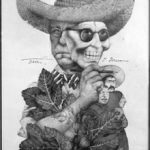Editor’s Page
By Alejandro Grattan-Dominguez
HEMINGWAY—Half a Century Later

Given that the author has been repeatedly savaged by modern-day literary critics, his style lampooned and caricaturized, and even his sexual preferences brought into question, the mystery deepens: why can’t the world finally get the man out of its system?
Best-selling novelists come and go (some often, to the bank, like billionaire Dan Brown of The Di Vinci Code fame), but few had the panache, film-star looks, courage and good luck that Hemingway did. He was in Italy during the First World War, Paris in the early 20s, Spain during its Civil War, Europe during WWII, Kenya in the early 50s and Cuba in the mid-50s.
From these experiences came the novels that made him world-famous: A Farewell to Arms, The Sun Also Rises, For Whom the Bell Tolls, Across the River and Into the Trees (his only critical failure), and The Old Man and the Sea. By the late 50s, however, it didn’t matter what he wrote anymore: he had become his own best creation—a handsome, macho, best-selling author and an expert on fishing, shooting, boxing and bull-fighting, stomping around the world as if demanding to see the manager.
In the Fifties, the writer A.E. Hotchner journeyed to Cuba to interview Hemingway—and always remembered his first impression of him. “I never met a man so happy to be who he was. His love of his life filled the room.” At a time when many other famous novelists like J.D. Salinger and Philip Roth seemed miserable and ill-suited to their fame, Hemingway was…well, unabashedly Hemingway!
When he died in 1961, the world mourned the loss of one of the 20th century’s most charismatic personalities. Quickly forgotten was how hard the man had worked to perfect both his style, as well as his stories. The literary gadfly George Plimpton was astounded to learn that Hemingway had rewritten the last page of A Farewell to Arms 39 times. “I was trying to get the words right,” was the author’s simple explanation. Also lost in the hoopla was the sensitivity that he had hidden so well over the years but revealed in his deeply touching memoir, A Moveable Feast.
As for his unique style of writing, the citation for his Nobel Prize for Literature reads, “For his forceful and style-making mastery of modern narration.” Not bad—but not quite enough. Hemingway had little regard for “the literary boys” who considered poetic prose more important than compelling stories and memorable characters. Rather than “pretty up” his work with decorative adverbs, adjectives and phrases, he put his stock in unique nouns, muscular verbs and some of the best dialogue ever written.
His style is suggestive rather than direct. When Hollywood was about to remake A Farewell to Arms in 1957, the producer asked a famous screenwriter to list as a lead-in to the screenplay itself all the scenes in the novel. Later, the producer was furious, claiming the writer had left out several of the book’s best scenes. In reality, those scenes were never written, but simply inferred—and if that’s not great writing, they should come up with another definition of “great.” Call it subliminal story-telling—and yet another reason why Hemingway’s work continues to enthrall readers all over the world.
- April 2024 – Issue - March 31, 2024
- April 2024 – Articles - March 31, 2024
- April 2024 - March 31, 2024







